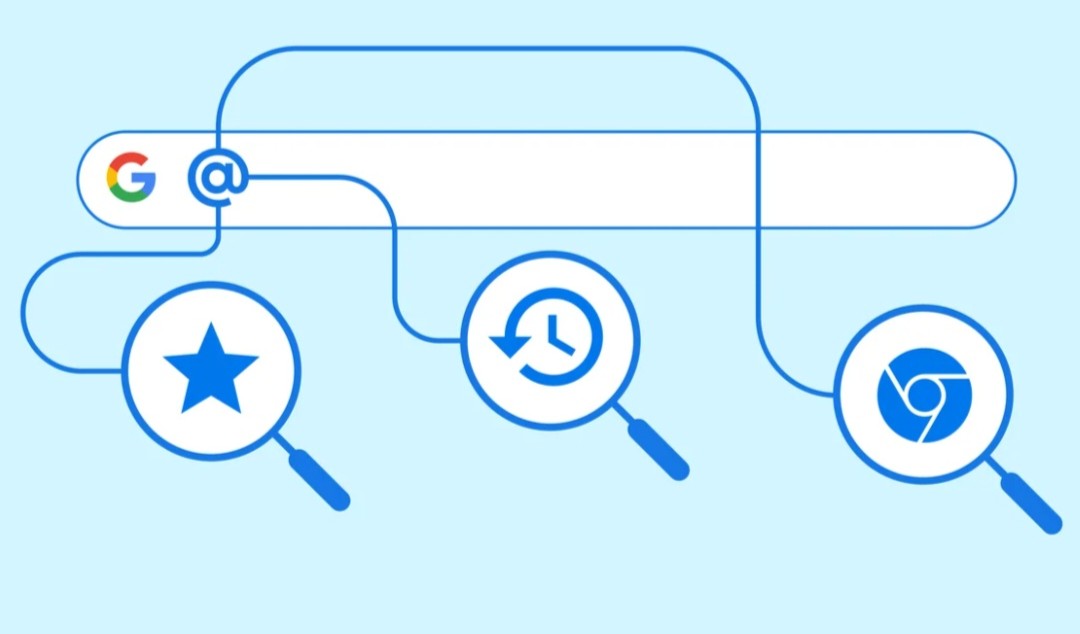Google Chrome’s address bar, also known as the Omnibox, is a versatile tool that can be used for more than just entering URLs. It can also be used to search across various tabs, bookmarks, and your browsing history. This feature provides a convenient way to quickly find and navigate to specific content without having to manually sort through multiple tabs or sift through your extensive bookmark collection or browsing history.
To search through open tabs, simply type a keyword or phrase into the address bar, and Chrome will display a dropdown menu with the corresponding open tabs. This is especially useful when you have numerous tabs open and are having difficulty locating a specific one.
When it comes to bookmarks, Chrome’s address bar makes it easy to find a bookmarked website without having to navigate through the bookmark manager. By typing the title or URL of the bookmark into the address bar, Chrome will display the bookmark and let you directly jump to the page.
Furthermore, the address bar also allows you to search your browsing history. By entering a keyword or phrase, Chrome will display any previously visited websites that match your search. This can be a time-saver when you’re trying to find a website you previously visited but didn’t bookmark.
In addition to these functionalities, the address bar also features auto-suggestions and auto-completion, which can help speed up your browsing and searching process. It can also perform calculations and conversions directly within the bar, saving you the need to open a separate tab or application.
In conclusion, the address bar in Google Chrome is a powerful tool that can significantly enhance your browsing experience. By allowing you to search tabs, bookmarks, and history directly from the bar, it provides a quick and convenient way to navigate the web.

Utilize @tabs, @bookmarks, and @history Shortcuts
Utilizing @tabs, @bookmarks, and @history shortcuts can significantly enhance your browsing experience, making it faster and more efficient. @Tabs allow you to have multiple web pages open at the same time, within the same window. This is particularly beneficial when working on a project, researching, or browsing multiple sites concurrently. By right-clicking on a link and selecting ‘open in a new tab,’ you can keep the original page open while exploring a new one.
On the other hand, @bookmarks make it possible to save and organize specific web pages for later reference. By clicking the star icon in the address bar, you can easily bookmark a webpage. You can also create folders to categorize your bookmarks and keep them tidy.
Lastly, the @history shortcut is a function that keeps track of all the websites you have visited. It can be accessed by clicking on the history tab on your browser. This feature is incredibly helpful when you need to revisit a site but can’t remember the exact URL.
Furthermore, there are numerous keyboard shortcuts for these features. For instance, you can use Ctrl+T to open a new tab, Ctrl+D to bookmark a page, and Ctrl+H to open your browsing history.
In conclusion, mastering the use of @tabs, @bookmarks, and @history shortcuts can drastically improve your productivity and browsing experience. Not only do they save time, but they also keep your workspace organized and make it easier to navigate the web. Despite being often overlooked, these browser tools are essential for anyone seeking to maximize their online efficiency.
Speed Up with Custom Site Search Shortcuts
Developing a custom site search shortcut can significantly enhance your online efficiency, saving valuable time and effort. By integrating search shortcuts into your browser or website, you can access information faster, simplifying your navigation process. Instead of manually typing in a website’s URL and then using its search engine, you can leap directly to your desired search results with a simple trick.
These shortcuts can be customized to your specific needs, enabling you to quickly find information on the sites you use most frequently. For example, you might set up a shortcut for a specific news site or database you often reference, allowing you to bypass the home page and search directly from your browser bar. Not only does this method expedite the process of accessing information, but it also reduces the likelihood of encountering irrelevant search results. It’s crucial to note that setting up these shortcuts requires a basic understanding of browser settings and possibly even some coding knowledge, depending on your chosen platform and the complexity of your desired shortcuts.
Nonetheless, the time you invest in learning these skills and setting up your shortcuts can pay dividends in the long run, increasing your productivity and streamlining your online activity. Furthermore, these shortcuts can be beneficial on both a personal and professional level, whether you’re quickly looking up a recipe or performing extensive research for a work project. In conclusion, custom site search shortcuts are powerful tools that can greatly enhance your browsing efficiency, providing you with a faster, more direct path to the information you need.

Enhance Browsing Efficiency
Enhancing browsing efficiency is a crucial aspect of modern digital life. With the ever-increasing volume of information available online, it is vital that users can navigate this data in a quick and effective manner. To optimize browsing efficiency, users can take several steps. Firstly, it’s important to have a reliable and speedy internet connection. Slow or unstable connections can significantly hinder your browsing experience. Another measure is to keep your browser updated to the latest version. Updates often contain performance improvements which can speed up your browsing.
Clearing your browser cache and cookies periodically is another method to boost browsing speed. Over time, these can accumulate and slow down your computer. However, remember that clearing cookies may also remove saved passwords and sites preferences. Using browser shortcuts can also enhance your browsing efficiency. Shortcuts like Ctrl+T for a new tab, Ctrl+W to close a tab, or Ctrl+Shift+T to reopen a closed tab can save you a lot of time.
Furthermore, using a browser with an efficient search engine can significantly enhance your online navigation. Some browsers are designed to provide faster load times and less computer memory usage. Additionally, using extensions or add-ons can greatly boost your browsing experience. For instance, ad-blockers can remove distracting and unnecessary advertisements, improving page load times.
Remember, too, that organization is key. Bookmarking frequently visited sites or using a start page with links to your favorite sites can shave off time spent looking for these sites. Try to keep your tabs organized – too many open at once can slow down your computer and make it difficult to find what you need.
Lastly, it’s vital to secure your browsing. Using browser security features and a trustworthy antivirus program can prevent malware or spyware from slowing down your system. Enhancing browsing efficiency is not just about speed, it’s also about ensuring a safe and seamless online experience.
Quickly Access Frequently Visited Sites
Easily accessing frequently visited sites is an integral part of enhancing your online experience, contributing to productivity, and saving time. It’s a feature that has been incorporated into various web browsers, allowing users to bookmark their favorite sites, thus eliminating the need to type in the full URL every time they want to visit the site. Also, many browsers offer a customizable homepage or new tab page where you can pin your most visited sites for quick and easy access. This feature is particularly useful for those who often visit a set number of sites for work, education, or personal interest.
Another effective method to quickly access frequently visited sites is by utilizing the browser’s history function. It not only provides a chronological list of all the sites you’ve visited but many modern browsers also highlight the most visited ones. A more advanced feature that some browsers offer is predictive typing, where the browser predicts and auto-completes the website you are likely to visit as you start typing in the URL. This works based on the frequency and recentness of your visits. Lastly, using a password manager or enabling the ‘remember me’ function on websites where you have accounts can also expedite the process of accessing your favorite sites by automatically filling in your login information.
However, it’s essential to keep in mind the importance of online security and privacy while using these features, especially when accessing websites that contain sensitive personal information. By efficiently using these features and tools, you can drastically improve your browsing experience and make the most of your time online.

Simplify Your Online Navigation
In the modern era, where the internet has become an integral part of our everyday life, it’s crucial to simplify online navigation for an efficient and stress-free digital experience. The first step to accomplish this is to organize your bookmarks or favorites, which are essentially shortcuts to your most visited sites. By categorizing them into folders or using tags, you can quickly locate the site you’re looking for without having to sift through a cluttered list.
Another strategy is to utilize keyboard shortcuts, which can expedite tasks and reduce dependence on the mouse. Many popular browsers offer a range of shortcuts that can help you navigate the web more swiftly, such as opening new tabs or windows, refreshing pages, and moving between tabs. Additionally, consider using a password manager to streamline the process of logging into various accounts. These tools securely store your login credentials and auto-fill them when needed, saving you the hassle of remembering multiple passwords.
Browser extensions can also enhance your online navigation. These small software modules add specific features or functionalities to your browser, from blocking unwanted ads to improving search capabilities. Lastly, don’t underestimate the power of a good search engine. Knowing how to use search operators and filters can refine your search results and lead you directly to the information you’re after. The internet can be a vast and overwhelming place, but by adopting these strategies, you can simplify your online navigation and make your digital experience far more enjoyable and efficient.
Streamline Your Web Experience
Streamlining your web experience is a critical aspect of optimizing your online activities, whether for personal, educational, or business purposes. The process of streamlining involves organizing, simplifying, and enhancing your web interactions to achieve a seamless, efficient, and more enjoyable experience. This could be achieved through various ways like adopting the use of modern browsers that offer advanced features to improve your browsing efficiency. For instance, they can provide capabilities such as tab grouping, syncing across devices, or password management.
Additionally, utilizing bookmarking tools can help you quickly access your favorite or frequently visited websites, hence saving time and improving productivity. Browser extensions are another way to enhance your web experience. These are small software modules that add a specific feature or functionality to your browser, tailored to your individual needs and preferences. For example, ad-blockers help eliminate distractions, while SEO tools can assist in digital marketing efforts.
Moreover, embracing tools and platforms that promote multi-platform synchronization can be helpful in streamlining your web experience, especially if you use multiple devices. They ensure that your data and progress are seamlessly synced across all your devices, providing a consistent experience.
Regularly updating your software and applications is also an essential part of the streamlining process. Updates often come with performance enhancements and new features designed to improve user experience. Also important is the habit of regularly clearing cache and cookies, as accumulated data can slow down your browsing speed over time.
In conclusion, streamlining your web experience is all about personalizing your online interactions to fit your needs and preferences, adopting tools that enhance your efficiency, and keeping your software up-to-date. By doing so, you can enjoy a hassle-free, efficient, and more satisfying web experience.
